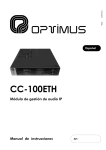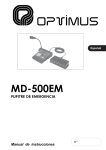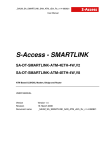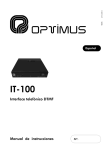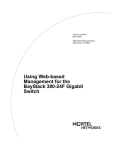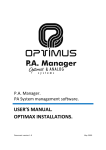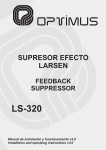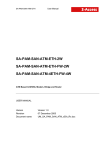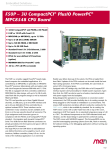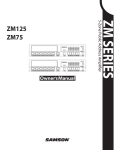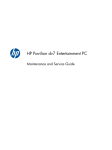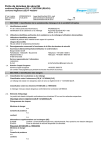Download DC-600ETH
Transcript
9I040 27/12/10 DC-600ETH Control central and paging desk Contents 1. INTRODUCTION ................................................................................................................... 6 2. FRONT VIEW ........................................................................................................................ 7 3. REAR VIEW .......................................................................................................................... 9 4. CONNECTIONS ..................................................................................................................... 9 4.1. Standard connection ................................................................................................. 9 4.2. Connection in installations with redundant Ethernet network and double power supply ..... 10 4.3. Connection of a music source to the desk................................................................... 10 4.4. Connection of the input contacts ............................................................................... 11 4.4.1. Connection of the input contacts in Emergency System Mode ............................ 11 4.4.2. Connection of the input contacts in Announcement System Mode ...................... 11 4.5. Fitting the ETHERCON NE8MC connectors and compatibility with RJ45 ............................ 12 5. SETTINGS AND CONFIGURATION ...................................................................................... 13 6. PRE-RECORDED MESSAGES ................................................................................................ 15 6.1. Pre-recorded messages resident in the MP3 circuit memory .......................................... 15 6.1.1. Characteristics ........................................................................................... 15 6.1.2. Transfer of messages to the MP3 memory of the desk...................................... 15 6.2. Pre-recorded messages resident in the flash memory of the Coldfire circuit (WAV) ........... 16 6.2.1. Characteristics ........................................................................................... 16 6.2.2. Transfer of messages to the Coldfire flash memory.......................................... 16 7. STARTING UP A DESK ........................................................................................................ 17 7.1. Configuration of the desk in the installation by means of the P.A. Manager software ......... 17 7.2. Desk configuration parameters ................................................................................. 18 7.2.1. General tab ............................................................................................... 18 7.2.2. Parameters 1 tab........................................................................................ 21 7.2.3. Parameters 2 tab........................................................................................ 22 7.2.4. Availability tab ........................................................................................... 23 7.3. Connecting the equipment in the installation structure ................................................. 23 7.4. Connection to the installation network ....................................................................... 24 7.5. Sending configurations to the desk ........................................................................... 24 7.6. Editing the configured parameters ............................................................................ 24 8. CHANGE OF THE IP ADDRESS OF THE UNIT BY SOFTWARE ................................................ 25 9. NAVIGATION THROUGH THE DESK MENUS ........................................................................ 27 10. MENU STRUCTURE ............................................................................................................. 28 11. OPERATIONS FROM THE DESK ........................................................................................... 30 11.1. General operations .............................................................................................. 30 11.1.1. User levels and changes .............................................................................. 30 11.1.2. Change of menu language ........................................................................... 30 11.2. Basic 11.2.1. 11.2.2. 11.2.3. DC-600ETH version 1.4 operations in zone selection mode ................................................................. 31 Sending a live paging to a zone .................................................................... 31 Sending a live paging to a group................................................................... 31 Sending a live paging to several zones and/or groups ...................................... 31 4 DC-600ETH Control central and paging desk 11.2.4. Sending a pre-recorded general purpose message to zones or groups ................ 31 11.2.5. Sending a Warning message to zones or groups.............................................. 32 11.2.6. Sending an Evacuation message to zones or groups ........................................ 32 11.2.7. Display of busy zones ................................................................................. 32 11.2.8. Information about busy zones, unavailable zones and zone errors, after sending an announcement or message ...................................................................................... 32 11.3. Basic 11.3.1. 11.3.2. 11.3.3. 11.3.4. 11.3.5. operations in Emergency Mode...................................................................... 33 Enter Emergency Mode ............................................................................... 33 Exit Emergency Mode .................................................................................. 33 Sending a live voice emergency announcement .............................................. 33 Sending a pre-recorded warning message in Emergency Mode .......................... 33 Sending a pre-recorded evacuation message in Emergency Mode ...................... 33 11.4. Advanced operations ........................................................................................... 34 11.4.1. Changing the ADMINISTRATOR password....................................................... 34 11.4.2. Changing the OPERATOR password ............................................................... 34 11.4.3. Modifying the volume of a zone .................................................................... 34 11.4.4. Monitoring pre-recorded MP3 messages ......................................................... 34 11.4.5. Configuring the origin of the WARNING and EVACUATION messages .................. 35 11.4.6. Configuring the WARNING and EVACUATION button messages .......................... 35 11.4.7. Assigning the Emergency Group ................................................................... 35 11.4.8. Updating the MP3 memory ........................................................................... 36 11.4.9. Formatting the MP3 memory ........................................................................ 36 11.4.10. Changing the IP address of the desk by means of the keypad ........................... 36 11.4.11. Re-establishing the IP address on the desk by DIP switch ................................. 36 12. SYSTEM ALARMS ................................................................................................................ 36 12.1. Alarms on the LCD screen of the desk .................................................................... 36 12.2. Alarm acoustic indicator (buzzer) .......................................................................... 37 12.2.1. Acceptance of an alarm ............................................................................... 37 12.2.2. Activation or deactivation of the acoustic indicator .......................................... 37 12.3. Alarm light indicator ............................................................................................ 37 12.4. List of alarms ..................................................................................................... 38 13. DIMENSIONS ..................................................................................................................... 39 14. TECHNICAL SPECIFICATIONS ............................................................................................ 39 15. NETWORK SPECIFICATIONS .............................................................................................. 40 16. SOFTWARE AND FIRMWARE VERSIONS ............................................................................. 42 17. DOCUMENT VERSION TRACKING ....................................................................................... 42 18. GUARANTEE ....................................................................................................................... 43 DC-600ETH version 1.4 5 DC-600ETH Control central and paging desk 1. INTRODUCTION Control central with connection to IP network. Supports the broadcast of announcements and music through an IP network, via streaming, in addition to control data and equipment configuration. Principal characteristics: Digital audio and control data via an IP connection (UDP/IP Multicast). Primary and secondary power supply surveillance. Double Ethernet connection for installations with redundant network systems. Dispatch of announcements to zones and/or groups. Operation in stand-alone mode or with P.A. Manager control software. Activation of pre-recorded general purpose messages. Surveillance of equipment operation by means of P.A. Manager software and/or basic TELNET functions. Key for repetition of the last live voice message. IP address configuration: o By means of a DIP switch, facilitating the replacement of equipment in an installation. o By means of the desk configuration menus. o In flash memory, through software. Constant (IP) notification of the equipment status by means of Heart beat. Special features as an emergency desk, with broadcast of live voice messages, evacuation and warning message. Warning and evacuation message activation buttons. Distinct work modes: Zone Selection Mode and Emergency Mode. Activation of emergency mode: o By activation of a contact. Volume control of digital amplifiers. o Via password protected keypad. Pre-recorded messages resident in the desk, located in: o By pressing the Evacuation or Warning button (configurable). o Flash memory (remotely updateable by IP). Announcements with or without a preannouncement tone (Gong). o MP3 memory, locally updateable through USB connection. Customizable gong. Display of system alarms. Supports the connection of a music source, sending the music program via IP. Display of zone status. Alarm LED indicator. Critical path surveillance (from capsule). Configurable input contacts (emergency mode / announcement mode). Internal status surveillance. Monitor loudspeaker. DC-600ETH version 1.4 6 DC-600ETH Control central and paging desk 2. FRONT VIEW ATTENTION: WHEN CONNECTING THE CC-600ETH BOX TO THE IP NETWORK, ENSURE THAT THE CONNECTORS MARKED “TO SWITCH” ARE USED. IF THE CONNECTORS MARKED “TO OPTIMUS EQUIPMENT” ARE USED BY ERROR, THE SWITCH OR ROUTER IN THE INSTALLATION MAY BE DAMAGED. Figure 1 (1) Microphone (2) WARNING button Pre-evacuation announcement activation key. Functionality: a) In emergency mode, it sends the message assigned to the button to the emergency group. b) In button emergency mode, it goes into emergency mode and sends the message assigned to the button to the emergency group. c) In zone selection mode, it sends the message assigned to the button to the zone selected. (3) EVACUATION button Evacuation announcement activation key. Its functionality is the same as the Warning button, but it has priority over this button (when the EVACUATION button is activated, the assigned message is activated and it cuts off the WARNING message if this is being played). DC-600ETH version 1.4 The messages assigned to the WARNING and EVACUATION buttons can be stored in the desks or in the power units of the OPTIMAX series. Both equipment units have two memories for storing messages: flash memory (WAV) and MP3 memory. Depending on the configuration, the messages assigned can be the following: Zone (amplifier) Desk Flash memory (WAV) Message 1, 2 or 3 Message 1 or 2 Memory (MP3) Message 1 or 2 Any MP3 (4) MENU navigation keys and OK/CANCEL selection (5) Monitor loudspeaker This serves to monitor the MP3 messages and the music input of the desk itself. (6) Numeric keypad 7 DC-600ETH Control central and paging desk (7) GONG+TALK key (19) Used to send a live paging preceded by a GONG. First, select the zones to which the announcement is to be sent. Hold the key down while you speak. Indicates the audio level of the microphone, the MP3 messages and the music input of the desk. The LED marked Peak indicates that the signal is saturated. This LED should not light. (8) TALK button (20) Used to send a live voice announcement. First, select the zones to which the announcement is to be sent. Hold the key down while you speak. LINK: When lit, it indicates connection to the network through the ETHERNET A or B inputs. (9) REP key Key for repetition of the last live voice message sent. MIC LEVEL indicator ETH A and B indicators ACT: When it blinks, it indicates that data is being sent or received through the ETHERNET A or B inputs. (21) Interconnection cables between the desk and the junction box. (10) PLAY key Used to send a pre-recorded message. First, select the message as well as the zones to which it is to be sent. (22) (11) (23) PLAY indicator Indicates that a pre-recorded message is being played. Indicates that the interconnection box is receiving power. TALK indicator When it lights, it indicates that you can begin to make the announcement. (13) GONG indicator When it lights, it indicates that the desk is generating the GONG. (14) BUSY indicator When it lights, it indicates that the system is busy. (15) EMERGENCY MODE indicator POWER SUPPLY 1 input 24 V DC input to power the desk. (24) (12) POWER indicator POWER SUPPLY 2 input 24 V DC input to power the desk. The power supply inputs have been doubled, so that if—on account of safety regulations—the installation so requires, two independent power supplies can be connected. (25) Connector A “To OPTIMUS Equipment” Connection A between the desk and the CC-600ETH connection box. (26) Connector B “To OPTIMUS Equipment” When it lights, it indicates that the desk is in emergency mode. Connection B between the desk and the CC-600ETH connection box. (16) (27) ETHERCON aerial connectors for connection to the IP network. ALARM indicator Indicates an alarm. Software configurable. (17) POWER indicator (28) Connector B “To Ethernet Switch” Indicates that the desk is receiving power. Used, in a redundant network, as a secondary connection to the ETHERNET network. (18) (29) Display Connector A “To Ethernet Switch” Used for connection of the desk to the IP network. DC-600ETH version 1.4 8 DC-600ETH Control central and paging desk 3. REAR VIEW (1) 24 V DC power supply input It can be used to power the desk without the CC-600ETH connection box. (2) I1, I2 and I3 Configurable input contacts. (3) MESSAGE UPDATE connector USB connector. Through this connector, pre-recorded messages can be copied into the internal MP3 memory of the desk, where up to 16 Mb of audio files in MP3 format can be stored. Figure 2 (4) ETH B connector Used, in a redundant network, as a secondary connection to the IP network. (5) ETH A connector Used for connection of the desk to the IP network. (6) RCA connectors R and L They support the connection of a music source, sending the music program via IP. 4. CONNECTIONS 4.1. Standard connection Connection to the Ethernet switch ATTENTION: WHEN CONNECTING THE CC-600ETH BOX TO THE IP NETWORK, ENSURE THAT THE CONNECTORS MARKED “TO SWITCH” ARE USED. IF THE CONNECTORS MARKED “TO OPTIMUS EQUIPMENT” ARE USED BY ERROR, THE SWITCH OR ROUTER IN THE INSTALLATION MAY BE DAMAGED. Figure 3 DC-600ETH version 1.4 9 DC-600ETH Control central and paging desk 4.2. Connection in installations with redundant Ethernet network and double power supply Figure 4 Connection to the Ethernet switch ATTENTION: WHEN CONNECTING THE CC-600ETH BOX TO THE IP NETWORK, ENSURE THAT THE CONNECTORS MARKED “TO SWITCH” ARE USED. IF THE CONNECTORS MARKED “TO OPTIMUS EQUIPMENT” ARE USED BY ERROR, THE SWITCH OR ROUTER IN THE INSTALLATION MAY BE DAMAGED 4.3. Connection of a music source to the desk Music source Figure 5 DC-600ETH version 1.4 10 DC-600ETH Control central and paging desk 4.4. Connection of the input contacts The input contacts of the DC-600ETH have two different modes of operation: Emergency System Mode and Announcement System Mode. To define the mode of operation of the contacts, see section 7.2.2, number (10). In both cases, the connections are the same, although the functionality of the contacts varies. 4.4.1. Connection of the input contacts in Emergency System Mode Input CONTACT "I1": If this is connected to the ground contact, the desk goes into emergency mode and remains in this mode as long as the contact is activated. EMERGENCY SYSTEM Input CONTACT "I2": By connecting it to the ground contact, it is used to activate the warning message. If the desk is in selection by zones mode, it is necessary to select the zone or zones for which the message is intended by means of the numeric keypad on the desk and then to activate this contact. The warning message is repeated while the contact is activated. If the desk is in emergency mode, when this contact is activated, the warning message will be sent to the emergency group (by default to all the zones). The message is repeated while the contact is activated or until the emergency mode is cancelled. Input CONTACT "I3": By connecting it to the ground contact, it is used to activate the evacuation message. Figure 6 If the desk is in selection by zones mode, it is necessary to select the zone or zones for which the message is intended by means of the numeric keypad on the desk and then to activate this contact. The evacuation message is repeated while the contact is activated. If the desk is in emergency mode, when this contact is activated, the evacuation message will be sent to the emergency group (by default to all the zones). The message is repeated while the contact is activated or until the emergency mode is cancelled. 4.4.2. Connection of the input contacts in Announcement System Mode In this mode, the rear contacts function as if they were the GONG+TALK, TALK and REPEAT keys on the desk. Ideal for remote control of the desks when integrators are used. Input CONTACT "I1": If this is connected to the ground contact, the REPEAT function is activated, in the same way as when the REP key on the desk is pressed. This functionality is activated by pressing for at least 500 ms. DC-600ETH version 1.4 11 DC-600ETH Control central and paging desk If you wish to stop the repetition of the message before it ends, activate contact I1 once again. ANNOUNCEMENT SYSTEM MODE Before activating the repeat function, it is necessary to select the destination zones and/or groups for the message. Input CONTACT "I2”: If this is connected to the ground contact, the TALK function is activated, in the same way as when the TALK key is pressed on the desk keypad. This functionality remains active while the contact remains activated. Before activating the TALK function, it is necessary to select the destination zones and/or groups for the message. Input CONTACT "I3": If this is connected to the ground contact, the GONG+TALK function is activated (Pre-announcement tone + Talk), in the same way as when the GONG+TALK key is pressed on the desk keypad. This functionality remains active while the contact remains activated. Figure 7 Before activating the GONG+TALK function, it is necessary to select the destination zones and/or groups for the message. 4.5. Fitting the ETHERCON NE8MC connectors and compatibility with RJ45 The desk has NE8MC model Ethercon connectors. Four are pre-fitted on the two interconnection cables between the desk and the CC-600ETH box and another two are supplied as accessories for the connection of the box with the switch. These connectors reinforce the connection and so it is highly recommended to fit them. The table to the right shows the RJ45 brands and models that are compatible with this connector. Figure 8 RJ 45 CONNECTOR TYPE HIROSE NEXUS MOLEX MH CONNECTORS EFB BOMAR CANFORD BLACK BOX STEWART EUCON DRATHEX DC-600ETH version 1.4 RJ PART No. TM11 E5088-011021 44915-0011 RJ45SRB-FS-R 37541.3 300068S 46-606 FM731 943-SP-370808S MPS-88R30 220.9026 220.0210 220.0200 220.0201 12 DC-600ETH Control central and paging desk 5. SETTINGS AND CONFIGURATION Situated on the underside of the desk, these controls can be used to configure the IP address, the microphone volume, the volume of the monitor and the sensitivity of the analog input (rear RCA connectors). In an octet, each bit can have the value 0 (DIP switch OFF) or 1 (DIP switch ON). In order to obtain the decimal value of the octet, the decimal values of each bit that is in the ON position must be added up (1, 2, 4, 8, 16, 32, 64 and 128). (1) Remove screws a and b indicated in Figure 9 to gain access to the DIP switches. This figure shows an example in which the IP address 192.168.100.128 is configured. MIC. VOLUME Adjustment of the microphone gain. Volume of the monitor loudspeaker. On the next page, Table I shows all the DIP switch combinations from 0 to 255. (3) (4) (2) SPEAKER VOLUME IP ADDRESS DIP switches to configure the IP address of the desk. This address identifies the equipment unit in the network, so each unit must have a unique IP address. NB: The IP address can also be set by software (see section 8) or by the keypad (see section 11.4.10). If this action is taken, the desk IP ADDRESS DIP switches cease to be operative. An IP address is represented by means of a 32bit binary number. The IP addresses are expressed as decimal notation numbers: the 32 bits of the address are divided into four octets (an octet is a group of 8 bits). In the desk, each octet is represented by A0 to A7 for the first octet, B0 to B7 for the second octet, C0 to C7 for the third octet, and D0 to D7 for the fourth octet. MP3 FIRMWARE UPDATE Firmware download connector for the MP3 circuit. Contact Optimus technical staff for its use. Remove screws c, d, e and f indicated in Figure 9 to gain access to the connector. (5) MODE CONFIG. Configuration DIP switch to enable the MP3 firmware download. Contact Optimus technical staff for its use. Remove screws c, d, e and f indicated in Figure 9 to gain access to the DIP switch. (6) ANALOG INPUT SENSITIVITY Internal jumper for configuration of the analog audio input sensitivity to either 0 dB or -20 dB. Remove screws c, d, e and f indicated in Figure 9 to gain access to the jumper. IP address Figure 9 DC-600ETH version 1.4 13 DC-600ETH Control central and paging desk Table I. Configuration of the IP address. DC-600ETH version 1.4 14 DC-600ETH Control central and paging desk 6. PRE-RECORDED MESSAGES The desk has two internal memories in which files can be stored for subsequent use as pre-recorded messages: MP3 Circuit Memory and Coldfire Flash Memory. 6.1. Pre-recorded messages resident in the MP3 circuit memory 6.1.1. Characteristics Access/Updating of messages Through the USB connector on the rear panel, by means of a PC. Memory capacity 16 Mb Maximum number of messages 20 File format MP3 6.1.2. Transfer of messages to the MP3 memory of the desk The files must be copied to the MP3 memory with a specific name format. Otherwise the messages cannot be played. The MP3 files must have the CRC protection activated (most recording programs support this option). This ensures constant surveillance of the integrity of messages 1 and 2 in the MP3 memory (files 0001… and 0002…). If there were to be any problem in these files, the desk displays and sends an alarm message through the Ethernet connection towards the different units in the installation that have the capacity to receive it (FC-600ETH, DC-600ETH, DVA-102ETH, UMX-02/0, control computer…). To transfer the MP3 files to the desk, connect the computer that contains the messages to the DC600ETH by means of the USB connector on the rear panel. Use the PC browser to copy the files to the MP3 memory of the desk, which will be shown as an additional disk unit. The files must be copied into the root directory of the unit; do not use folders. ATTENTION: Once the files have been copied to the desk, it is necessary to UPDATE the memory of the desk. To do so, follow the instructions in section 11.4.8. Updating the MP3 memory. DC-600ETH version 1.4 15 DC-600ETH Control central and paging desk 6.2. Pre-recorded messages resident in the flash memory of the Coldfire circuit (WAV) 6.2.1. Characteristics Access/Updating of messages Remotely, by means of a PC, through the IP connection Memory capacity 6 Mb Maximum number of messages 2 messages (maximum size of 3 Mb/message) .WAV File format Sampling rate: 48000 Hz, 24000 Hz and 12000 Hz (mono) Sample size: 16 bits 6.2.2. Transfer of messages to the Coldfire flash memory To transfer the WAV files to the flash memory, it is necessary to have a PC connected to the same IP network as the desk and to use the Optimax Flasher application. This application is supplied together with the P.A. Manager software. To install it, run the file Optimax Flasher x.x.exe which can be found in the folder 02_FIRMWARE of the installation CD and follow the instructions of the assistant. Once the software has been installed, proceed as follows: NB: The file transfer operations shown hereunder can be performed with version 2.6.3 and upwards of the Optimus Flasher software. . 1. Start the Optimax Flasher application. 2. Select the Advanced tab (1). 3. Enter the IP address of the desk in the IP Host field (2). (1) (2) 4. Select DC/FC600ETH from the Equipment Type drop-down menu (3). 5. Tick the box corresponding to the message that you wish to transfer (4) and indicate the route and file that you wish to use. (Local Message 1 corresponds to the EVACUATION message and Local Message 2 to the WARNING message). (3) (4) (4) (5) 6. Press the button Start Update Process (5) to begin to transfer the files. 7. Press OK when the process has been completed. 8. Exit the application (File>Quit). DC-600ETH version 1.4 16 DC-600ETH Control central and paging desk 7. STARTING UP A DESK To start up a DC-600ETH, proceed as follows: 1. By means of the P.A. Manager software, add the desk to the installation. Refer to section 7.1. 2. Configure the parameters of the desk. Refer to section 7.2. 3. Connect the unit to the installation structure. Refer to section 7.3. 4. Configure the IP address and make the connections. Refer to section 7.4. 5. Send configurations to the desk. Refer to section 7.5. If the desk is already configured, connect it and when it starts up, it will already be operative. a) If the installation has a Server PC, the desk will download the configuration variations from the Server PC in the installation. b) If the installation does not have a Server PC, on start-up the desk will use the configurations of its local memory. 7.1. Configuration of the desk in the installation by means of the P.A. Manager software To configure the desk, it is necessary to have a PC connected to the network that has the SCF-01 or SCM-01 (P.A. Manager) software. 1. If the software is the SCM-01, start the application, open the Options menu and select Installations (administrator user level is required). If the software is the SCF-01, start the application. NB: Prior to configuration of the desk parameters, it is necessary to have configured the parameters of the installation and the PA areas. 2. From the installation screen, click on the PA area to which you wish to add the desk. 3. Open the Add Equipment menu and select DC600ETH/FC600ETH. The desk configuration window appears. 4. Refer to section 7.2. Desk configuration parameters. DC-600ETH version 1.4 17 DC-600ETH Control central and paging desk 7.2. Desk configuration parameters 7.2.1. General tab (1) Name Enter a name to identify the equipment unit. Maximum of 50 characters. (2) (1) (3) (2) Priority source Click on the drop-down menu and assign one of the Priority type sound sources available to the desk. These sound sources are defined during the configuration of Modes and sound sources. Each sound source has a Mode or priority level assigned to it, and so the source selected will determine the priority of the desk with respect to the other audio signals in the installation when an announcement is sent (for more information, see the Optimax Installations Configuration Manual). (4) (7) (5) (8) (6) (9) (10) (11) MULTICAST DATA (see also page 19) (3) Program source (7) IP Multicast Configure this option if you have a music source connected to the desk (through the RCA connectors on the rear panel). Default setting 239.5.5.5. Do not modify this field unless the installation topology makes it necessary. All the units with an IP connection in the installation must have the same IP multicast address. Click on the drop-down menu and assign one of the Program type sound sources available to the desk. These sound sources are defined during the configuration of Modes and sound sources. Each sound source has a Mode or priority level assigned to it, and so the source selected will determine the priority with which the desk is to send the music with respect to the other audio signals in the installation (for more information, see the Optimax Installations Configuration Manual). IP DATA (4) IP Address Enter the IP address of the unit. This IP must be unique to the installation and it must coincide with the configuration of the DIP switches on the underside of the unit, or with the address configured through the Web connection (see section 8), or with the address configured through the keypad (see section 11.4.10). It must be a fixed IP address. (5) Netmask and (6) Gateway In installations that require this. Consult the network administrator of the installation. DC-600ETH version 1.4 (8) Multicast port Default setting 5000. Do not modify this field unless the installation topology makes it necessary. All the units with an IP connection in the installation must have the same multicast port. (9) Send “Heart beat” every n seconds Frequency with which the unit sends a heart beat signal to the multicast group. This signal informs the other units with an IP connection in the installation that the desk is operating perfectly. (10) Local Manager and (11) Global Manager Defines whether the desk is to function as a priority manager of the Optimax system, either locally at PA Area level or globally for the installation, and establishes the priority of this management with respect to other equipment units (1 = maximum priority). It is not advisable to activate this management on the DC-600ETH desk (see Notes on Local and Global Coordinators on page 20). 18 DC-600ETH Control central and paging desk a) Information about the multicast configuration on Optimax equipments It is possible to modify the multicast configuration of all the equipment units in the installation simultaneously. Proceed as follows: 1. From the installation screen, open the Options menu and select Multicast Configuration. 2. A window with the configurations of the multicast group appears. Double click on the data item that you wish to change. 3. Modify the value and click on OK. 4. Confirm the change by clicking on Yes. 5. Close the multicast configuration window by clicking on OK. ATTENTION: The values that are modified from the multicast configuration window affect all the equipment units in the multicast group in the installation. DC-600ETH version 1.4 19 DC-600ETH Control central and paging desk Default base Multicast addresses, ports and configurations Broadcast address Broadcast port Initial configuration download 255.255.255.255 3333 Multicast address Multicast port Initial configuration download 239.5.5.5 8001 Multicast address Multicast port Others Control data 239.5.5.5 5000 Heart beat every 10 seconds Global audio channels 239.1.0.x 6000 + x 8 simultaneous channels Local audio channels 239.1.PAArea.x 6000 + (PAArea*100) + x 5 simultaneous channels Valid ranges (according to the IANA Guidelines for IPv4 Multicast Address) Multicast address Control data Global audio channels Local audio channels Between 239.0.0.0 and 239.255.255.255 Between 239.0.0.0 and 239.255.255.255 Between 239.0.0.0 and 239.255.255.255 Multicast port Others Between 1025 and 65536 Heart beat between 1 and 65000 seconds. Between 1025 and 65536 1-50 simultaneous channels Between 1025 and 65536 1-50 simultaneous channels b) Notes on Local and Global Co-ordinators The system requires management of the digital audio channels at all times, so that the data may circulate freely across the network. This function is performed by two applications: one at a local level, known as LCC, which manages the digital channels at PA Area level, and another, known as GCC, which manages the digital channels at a global level (between different PA areas and/or servers). Each PA Area needs at least one LCC process on one of its equipment units. If there is more than one PA Area in an installation, and announcements have to made or music programs have to be sent between PA Areas, a minimum of one GCC process is required on an equipment unit in the installation. If the number of equipment units so permits, it is advisable to have each process available on at least two equipment units. In this way, the applications continue to work even when a fault in one of the equipment units occurs. There are specific equipment to run these applications: CC-100ETH, UMX-CC and UMX-ETH (Control). It is recommended that they are the ones who made the role of coordinator. If these equipment are not present in the installation, it is advisable that the COU02/0ETH, performs the functions of co-ordinator. The recommended order of priority depending on the model is as follows: CC-100ETH UMX-CC UMX-ETH (Control) > DC-600ETH version 1.4 COU-02/0ETH > SU-114N SU-214/0N > UP-xETH (Backup amplifier) > UP-xETH UMX-ETH (program or priority) > DVA-102ETH DC-600ETH FC-600ETH 20 DC-600ETH Control central and paging desk 7.2.2. Parameters 1 tab (1) Language Configures the language in which the messages appear on the LCD screen of the DC-600ETH. (2) Compressor Activates or deactivates the compressor of the microphone desk. (3) Buzzer The desk has a buzzer which is activated when an alarm is received. This control activates or deactivates the buzzer. (1) (2) (3) (4) (5) (6) (7) (8) (12) (9) (13) (10) (4) Keypad Sound Activates or deactivates the sound of the keys (PLAY, REP, TALK and GONG+TALK make no sound). (5) Capsule Surveillance Activates or deactivates surveillance of the microphone capsule. If this option is activated, the system will generate an alarm when a fault is detected in the capsule. (6) Power Supply Surveillance Activates or deactivates surveillance of the power supply to the junction box of the desk. If this option is activated, the system detects when either of the two power supply inputs to the junction box fails, and generates an alarm. (7) Program Return Activates or deactivates the return of the program signal to some zones after an announcement has been sent from the desk to these zones. (8) Emergency mode at buttons If this option is enabled, the desk will go into emergency mode whenever the WARNING or EVACUATION button is pressed. (9) VU meter Level Indicator The volume bar can show the audio signal level when a message is sent (Only during the announcement) or at all times. (10) Rear contacts functionality Configures the functionality of input contacts I1, I2 and I3 of the desk. Emergency / Warning / Evacuation. If this option is selected, when I1 is activated, the desk goes into Emergency System Mode; activating I2 launches the Warning DC-600ETH version 1.4 (11) (14) message; and activating I3 launches the Evacuation message. Repeat/Talk/Gong+Talk. Activates the Announcement System Mode functionality. Through this option the functions REP (repetition), TALK and GONG+TALK can be activated from contacts I1, I2 and I3 (I1=REP, I2=TALK, I3=GONG+TALK). (11) Operator Control and (12) Administrator Control In order to restrict access to certain functions of the DC-600ETH from the controls on the front, 3 user levels have been established: Basic, Operator and Administrator. Through these parameters, the Administrator password and the Operator password can be established. Basic: Default level when the unit is switched on. Without password. Allows basic operations such as sending pre-recorded messages and viewing the status of the volume. Operator: With password (by default 1234). In addition to all the operations available to the basic user, the zone volume can be modified. Administrator: With password (by default 1234). Without any restriction. (13) Emergency Mode Password for access to emergency mode. Default value 1234. 21 DC-600ETH (14) Associated Group Control central and paging desk of the Groups menu on the P.A. Manager software installations screen. Through this option, a group can be assigned to the Emergency Mode, so that this group will be the destination of the messages when the desk goes into Emergency Mode. To assign a group, the group must first have been created by means If this parameter is left without configuration (None-), the emergency messages are sent to all the zones. 7.2.3. Parameters 2 tab (1) Zone number Not used. (2) Mater Volume General volume of the desk audio. (3) Prerecorded Volume Volume of the pre-recorded messages of the desk. (1) (10) (6) (2) (4) Music Volume Audio volume of the music source connected to the desk. (5) Mic. Volume Audio volume of the desk microphone. (6) Prerecorded message Source Configures the origin of prerecorded messages activated by the WARNING and EVACUATION buttons on the desk. Paging Desk: Messages resident in the desk. Amplifier: Messages resident in the amplifier. It is only possible to select Amplifier if the installation has UP-ETH amplifiers. (7) Prerecorded message - Type Select the type of pre-recorded messages to be activated by the WARNING and EVACUATION buttons on the desk. (3) (4) (5) (7) (8) (9) (10) Timeout Active Keys (minutes) Time length during which the last zones and/or messages selection is available on the microphone desk display. Values between 1 and 254 minutes. Typewrite 255 to show it indefinitely. WAV: Pre-recorded WAV messages resident in the Coldfire flash memory of the unit. MP3: Pre-recorded MP3 messages resident in the MP3 circuit of the unit. (8) Evacuation Message Enter the number of the message that will be used as the EVACUATION message (EVACUATION button). (9) Warning Message Enter the number of the message that will be used as the pre-evacuation message (WARNING button). Logic diagram of the volume controls DC-600ETH version 1.4 22 DC-600ETH Control central and paging desk 7.2.4. Availability tab By clicking on this tab, it is possible to restrict or enable the access of a desk to specific zones, groups or PA Areas in the installation. (1) If this is not configured, the desk has access to all the zones in its own PA Area. Click on this tab if you wish to modify the default accessibility of the desk. (1) Enable available zones, groups or areas (2) (2) Tick this box if you wish to modify the default accessibility of the desk. When this option is activated, the desk will ONLY have access to the zones, groups and PA Areas that appear in the windows on the right. (2) (2) Add and Remove buttons Click on these to add or delete access to zones, groups and PA Areas. From the windows on the left, select the elements to which you wish to allow messages to be sent and click on the button Add to add them to the list on the right. 7.3. Connecting the equipment in the installation structure When equipment units are added to the installation, they appear in the structure with their name in red, preceded by the “disconnection” icon. While their status is shown as disconnected, these equipment units are not operative. To connect the equipment, proceed as follows: 1. In the installation structure, right click with the mouse on the disconnected equipment unit. = Unit disconnected 2. Click on Connect Equipment. The connection icon appears and the name of the equipment is shown in green. = Unit connected DC-600ETH version 1.4 23 DC-600ETH Control central and paging desk 7.4. Connection to the installation network 1. Before connecting the desk, configure the IP address by means of the DIP switches on the underside of the unit (see section 5). 2. Using the cables supplied with the desk, make the connections between the desk and the CC-600ETH connection box. 3. Connect the junction box to the IP network. ATTENTION: WHEN CONNECTING THE CC-600ETH BOX TO THE IP NETWORK, ENSURE THAT THE CONNECTORS MARKED “TO SWITCH” ARE USED. IF THE CONNECTORS MARKED “TO OPTIMUS EQUIPMENT” ARE USED IN ERROR, THE SWITCH OR ROUTER IN THE INSTALLATION MAY BE DAMAGED. 4. Connect the power supply to the connection box. 7.5. Sending configurations to the desk Before sending configurations to any equipment unit, it is advisable to save the configuration. To do this, open the File menu and select Save. 1. On the installation tree, right click with the mouse on the DC-600ETH that has just been configured and select the option Send configurations. 2. A progress bar appears. Upon completion, click on OK. You can exit the installation screen by opening the File menu and selecting Exit. The P.A. Manager software will start up automatically. 7.6. Editing the configured parameters If required, the configurations of the desk can be edited. Proceed as follows: 1. Open the installation screen of the P.A. Manager software. 2. In the installation structure, right click with the mouse on the name of the DC-600ETH desk whose configuration you wish to edit. 3. Select Edit Equipment. 4. The desk configuration window appears. Edit the parameters as required. 5. Once the parameters have been configured, click on the button OK. 6. Save the configuration by opening the File menu and selecting Save. 7. Send the configurations to the unit (Section 7.5). DC-600ETH version 1.4 24 DC-600ETH Control central and paging desk 8. CHANGE OF THE IP ADDRESS OF THE UNIT BY SOFTWARE It is possible to change the IP address of the unit by means of the DIP switches situated on the underside of the unit, by means of the desk configuration menus and by software. The software option allows the change to be made remotely, without the need for access to the desk. To make the change by software, from the installation screen of the P.A. Manager software right click with the mouse on the name of the unit and select the option Web Connection (1). (1) If the PC is remote with respect to the installation, open the Internet browser and enter the IP of the unit in the address bar (for example: http://10.1.1.2). This IP address is the address configured by means of the IP ADDRESS DIP switches situated on the underside of the desk or the address configured from the menus of the desk. In both cases, a web page belonging to the unit will load. NB: To view the page, it is necessary to deactivate the proxy in the configuration of the web page browser. Proceed as follows: 1. Enter the password in the Administrator Login section (2) (contact technical staff at Optimus and they will provide you with this) and click on the button Login. DC-600ETH version 1.4 (2) 25 DC-600ETH 2. Control central and paging desk Open the Expert menu (3) and click on the Set IP address option (4). (3) (4) ATTENTION: If the IP is activated by software, the functionality of IP address selection by DIP switches will be deactivated. Once the change has been made, it can be undone by deleting the IP software via the web, or by selecting the address 0.0.0.0 on the DIP switches and restarting the unit. 3. Write the new IP in the IP Address field (5) (for example: 10.1.1.100) and click on Save IP Address (6). (5) (6) ATTENTION: Once the IP address of the unit has been changed, it is necessary to modify this in the P.A. Manager software as well (see section 7.2.1) and send configurations to the unit (see section 7.5). DC-600ETH version 1.4 26 DC-600ETH Control central and paging desk 9. NAVIGATION THROUGH THE DESK MENUS The navigation buttons provide access to the various menus and configurations of the DC-600ETH. Basic menu navigation: Moves the user to the previous menu on the same level. Provides access to the menu selected on the screen. From the start screen, it shows the busy zones. From the start screen, it provides access to the main menu. Confirms or saves a data entry. Moves the user to the higher level menu. On the volume setting screen, it lowers the volume. Selects the element situated to the left of the present selection. Selects the element situated to the right of the present selection. On the volume setting screen, it increases the volume. Moves the user to the next menu on the same level. From the start screen, it shows the system alarms. DC-600ETH version 1.4 27 DC-600ETH Control central and paging desk 10. MENU STRUCTURE DC-600ETH version 1.4 28 DC-600ETH DC-600ETH version 1.4 Control central and paging desk 29 DC-600ETH Control central and paging desk 11. OPERATIONS FROM THE DESK In installations with a Server PC, when the DC-600ETH is restarted, this will download the configurations from the PC, so all the changes in configuration made from the desk keypad will be lost. 11.1. General operations 11.1.1. User levels and changes C. Enter as OPERATOR USER To restrict access to certain functions of the desk, 3 user levels have been established: Basic, Operator and Administrator. 1. Press OK to access the main menu. Basic Default level when the desk is switched on. Without password. Allows basic operations such as making live voice announcements, sending pre-recorded messages and viewing the status of the volume. Operator With password (by default 1234). In addition to all the operations available to the basic user, the zone volume can be modified. To change the password, refer to section 11.4.2. Administrator With password (by default 1234). Without any restriction. To change the password, refer to section 11.4.1. 2. Select USER and press OK. 3. Select LOGIN OPERATOR and press OK. 4. Enter the operator user password (1 2 3 4 by default) and press OK. D. End OPERATOR session 1. Press OK to access the main menu. 2. Select USER and press OK. 3. Select LOGOUT OPERATOR and press OK. If no key is pressed for 8 minutes, this operation is performed automatically. 11.1.2. Change of menu language 1. Press OK to access the main menu. A. Enter as ADMINISTRATOR USER 1. Press OK to access the main menu. 2. Select USER and press OK. 3. Select LOGIN ADMINISTRATOR and press OK. 4. Enter the administrator user password (1 2 3 4 by default) and press OK. 2. Select ADVANCED and press OK. 3. Select OPTIONS and press OK. 4. Select LANGUAGE and press OK. 5. Using the navigation keys / select a language and press OK. 6. Press the navigation key until you return to the start menu. B. End ADMINISTRATOR session 1. Press OK to access the main menu. 2. Select USER and press OK. 3. Select LOGOUT ADMINISTRATOR and press OK. If no key is pressed for 8 minutes, this operation is performed automatically. DC-600ETH version 1.4 30 DC-600ETH 11.2. Control central and paging desk Basic operations in zone selection mode 11.2.1. Sending a live paging to a zone 1. Using the numeric keypad, enter the identifier number of the zone where you wish to send the announcement. If you do not know the identifier number corresponding to the zone where you wish to send the announcement, press the key and then OK. A list will appear with the name of each of the zones. Use the navigation keys / to locate the required zone and press OK. To delete, use the DEL key. 2. Press and hold down GONG+TALK (or TALK). 3. When the green TALK LED lights and TALK… appears on the screen, you can begin to speak. 4. To end the announcement, release GONG+TALK (or TALK). 5. Press the navigation key to return to the start screen. 11.2.2. Sending a live paging to a group 1. Using the numeric keypad, press 0 and the identifier number of the group where you wish to send the announcement (groups always begin with the number 0). If you do not know the identifier number corresponding to the group where you wish to send the announcement, press the key and then OK. A list will appear with the name of each of the zones. Press once again and the list of groups will appear. Use the navigation keys / to locate the required group and press OK. To delete, use the DEL key. 2. Press and hold down GONG+TALK (or TALK). 3. When the green TALK LED lights and TALK… appears on the screen, you can begin to speak. 4. To end the announcement, release GONG+TALK (or TALK). 5. Press the navigation key to return to the start screen. DC-600ETH version 1.4 11.2.3. Sending a live paging to several zones and/or groups 1. Using the numeric keypad, enter the identifier numbers of each of the zones or groups where you wish to send the announcement, separating each element by means of the key (remember that the group identifier must begin with 0). If you do not know the identifier number corresponding to a zone or group where you wish to send the message: 1) Press the key and then OK. A list will appear with the name of each of the zones. Press the key once again and the list of groups will appear. Using the and keys, you can alternate between the list of groups and the list of zones. 2) From any of the lists, use the navigation keys / to select the element required and press OK. To delete, use the DEL key. 2. Press and hold down GONG+TALK (or TALK). 3. When the green TALK LED lights and TALK… appears on the screen, you can begin to speak. 4. To end the announcement, release GONG+TALK (or TALK). 5. Press the navigation key to return to the start screen. 11.2.4. Sending a pre-recorded general purpose message to zones or groups 1. Using the numeric keypad, enter the identifier numbers of the zone or group where you wish to send the message. If you do not know the identifier number corresponding to a zone or group, follow points 1) and 2) in section 11.2.3. To delete, use the DEL key. 2. Press or to position the cursor on the MP3: line and proceed to select the prerecorded message. 3. Using the numeric keypad, enter the identifier of the message that you wish to send. To send several messages in a chain, enter the identifiers of each message, separating each element by means of the key. 31 DC-600ETH If you do not know the identifier of the message, press OK and a list with the name of each message and its identifier will appear. Use the navigation keys / to locate the pre-recorded message that you require and press OK. To delete, use the DEL key. In zone selection mode, the messages assigned to the WARNING and EVACUATION buttons are not available when these messages are selected from the keypad. 4. Press the PLAY key. If you wish to stop the message before it ends, press the PLAY key. 5. Once the message has ended, press the navigation key to return to the start screen. 11.2.5. Sending a Warning message to zones or groups 1. Using the numeric keypad, enter the identifier numbers of the zone or group where you wish to send the message. If you do not know the identifier number corresponding to a zone or group, follow points 1) and 2) in section 11.2.3. Control central and paging desk To delete, use the DEL key. 2. Press the EVACUATION key. The message is played indefinitely until the EVACUATION key is pressed once again. The evacuation message takes priority over the warning message. If the evacuation message is activated while the warning message is being played, the warning message will stop. 3. Press the navigation key to return to the start screen. 11.2.7. Display of busy zones It is possible to view a list of busy zones (the zones must belong to the same PA Area as the desk or the desk must belong to a Global PA Area). 1. From the start menu, press . 2. The list of busy zones appears. You can navigate through the list by means of the and keys. The list shows the name of the busy zone and the mode (priority level) of the source occupying that zone. 3. Press the navigation key to return to the start screen. To delete, use the DEL key. 2. Press the WARNING key. The message is repeated until the WARNING key is pressed once again. 3. Press the navigation key to return to the start screen. If you have configured the desk enabling the option Emergency mode at buttons (see section 7.2.2), when WARNING or EVACUATION is pressed, the desk automatically goes into emergency mode and plays the message to the emergency group, regardless of the zone selected. 11.2.6. Sending an Evacuation message to zones or groups 1. Using the numeric keypad, enter the identifier numbers of the zone or group where you wish to send the message. If you do not know the identifier number corresponding to a zone or group, follow points 1) and 2) in section 11.2.3. DC-600ETH version 1.4 11.2.8. Information about busy zones, unavailable zones and zone errors, after sending an announcement or message Once an announcement has been sent, if it has not been possible to broadcast this in any of the zones or groups selected, a list appears of the zones in which an incident has occurred, classifying the incident as follows: Busy: Zones in which it has not been possible to play the announcement because an announcement of higher priority is being played. Unavailable: The zones or groups do not exist or access to these zones or groups from the desk is restricted. Zones error: Zones in which it has not been possible to play the announcement. Use the and keys to move from one list to another. Press OK to return to the start screen. 32 DC-600ETH 11.3. Control central and paging desk Basic operations in Emergency Mode Access to Emergency Mode is PASSWORD protected: 1 2 3 4 (by default). All the messages, be they live voice or pre-recorded, will be sent to the EMERGENCY GROUP (see sections 7.2.2. (14) and 11.4.7). The live voice announcement has priority over the Evacuation message, which in turn has priority over the Warning message. 11.3.1. Enter Emergency Mode 1. Press OK to enter the main menu. 11.3.3. Sending a live voice emergency announcement 2. Press OK once again to enter the EMERGENCY MODE menu. 1. Press and hold down GONG+TALK (or TALK). 3. Press OK once again to enter the LOGIN menu. 2. When the green TALK LED lights up, begin to speak. When you have finished, release GONG+TALK (or TALK). 4. Using the numeric keypad, enter the emergency mode password (1234 by default) and press OK. The EMERGENCY MODE LED flashes. 5. Press the navigation key until you return to the start screen. 11.3.2. Exit Emergency Mode 1. Press OK to enter the main menu. 11.3.4. Sending a pre-recorded warning message in Emergency Mode 1. Press the WARNING key. The message assigned to the Warning button is continuously repeated. 2. To stop it, press the WARNING key once again. 2. Press OK once again to enter the EMERGENCY MODE menu. 3. Select LOGOUT and press OK. 4. Press the navigation key to return to the start screen. 11.3.5. Sending a pre-recorded evacuation message in Emergency Mode 1. Press the EVACUATION key. The message assigned to the Evacuation button is continuously repeated. 2. To stop it, press the EVACUATION key once again. ATTENTION: If you have configured the desk enabling the option Emergency mode at buttons (see section 7.2.2, no.(8)), when the WARNING or EVACUATION button is pressed, the desk automatically goes into Emergency Mode, without the need for a password to be entered, and the message assigned is played. To exit Emergency Mode, refer to section 11.3.2. DC-600ETH version 1.4 33 DC-600ETH 11.4. Control central and paging desk Advanced operations Remember that in installations with a Server PC, when the DC-600ETH is restarted, this will download the configurations from the PC, so all the changes in configuration made from the desk keypad will be lost. 11.4.1. Changing the ADMINISTRATOR password (Requires Administrator user level). 1. Press OK to access the main menu. 2. Select ADVANCED and press OK. 3. Select OPTIONS and press OK. 4. Select CHANGE CODE ADMINISTRATOR and press OK. 5. Enter the new administrator password and press OK. 6. Repeat the new password and press OK. 11.4.2. Changing the OPERATOR password (Requires Administrator user level). 3. Use the navigation keys / to locate the zone where you wish to modify the volume and press OK. 4. Using the navigation keys /, select the volume channel that you wish to modify (LOCAL PROGRAM, LOCAL PRIORITY, ETH PROGRAM and ETH PRIORITY). 5. Modify the volume of the option selected by means of the navigation keys /. 6. Save the volume configuration by pressing the OK key or reject the changes by pressing DEL. The data with respect to the volume established are saved in the digital amplifier of the corresponding zone and in the Server PC, so the volume level established is maintained although the unit may be restarted. 7. Press the navigation key to return to the start screen. 1. Press OK to access the main menu. 2. Select ADVANCED and press OK. 3. Select OPTIONS and press OK. 4. Select CHANGE CODE OPERATOR and press OK. 5. Enter the new operator password and press OK. 6. Repeat the new password and press OK. 11.4.4. Monitoring pre-recorded MP3 messages (Requires Administrator user level). NB: This functionality is not available when the desk is sending a music program. 1. Press OK to access the main menu. 2. Select MONITOR MP3 and press OK. 11.4.3. Modifying the volume of a zone (Requires Administrator user level) Only the volume of zones that correspond to digital amplifiers can be modified. 1. Press OK to access the main menu. 3. Use the navigation keys / to locate the message that you wish to monitor. 4. Press OK to begin monitoring. 5. If you wish to stop the message, press OK once again. 6. Press the navigation key to return to the start screen. 2. Select VOLUMES and press OK. DC-600ETH version 1.4 34 DC-600ETH 11.4.5. Configuring the origin of the WARNING and EVACUATION messages (Requires Administrator user level). The WARNING and EVACUATION messages can be stored in the DC-600ETH desk or in the power units of the OPTIMAX series. If the desk is configured to store these messages, when they are activated, they are sent through the Ethernet connection to the emergency group zones. If, on the other hand, the configuration is such that the amplifiers contain these messages, when they are activated, the desk sends the order to the amplifiers to play the message. Control central and paging desk 5. Use the navigation keys / to select the type of message that you wish to assign (MP3 or WAV) and press OK. 6. Use the navigation keys / to locate the message that you wish to assign and press OK. 7. Press the navigation key to return to the start screen. NB: If this option is not configured and there are messages in the memory, message 1 in the MP3 memory of the desk is automatically assigned to the EVACUATION button and message 2 in the MP3 memory of the desk is assigned to the WARNING button. 1. Press OK to access the main menu. 2. Select ADVANCED and press OK. 3. Select MESSAGES and press OK. 4. Select MESSAGES SOURCE and press OK. ATTENTION: The messages from the desk assigned to the WARNING or EVACUATION buttons cannot be used as general purpose messages. 5. Using the navigation keys /, select the origin of the WARNING and EVACUATION messages: PAGING DESK or ZONE. 6. Press OK. 7. Press the navigation key to return to the start screen. 11.4.6. Configuring the WARNING and EVACUATION button messages (Requires Administrator user level). Both the desks and the amplifiers in the OPTIMAX series have two internal memories in which files can be stored for subsequent use as pre-recorded messages: MP3 circuit memory, for files in MP3 format Coldfire flash memory, for files in WAV format. This configuration establishes which memory the desk is to access in order to search for the evacuation or warning message, and what the content of each of these messages is. 1. Press OK to access the main menu. 2. Select ADVANCED and press OK. 3. Select MESSAGES and press OK. 11.4.7. Assigning the Emergency Group (Requires Administrator user level). This group will be the destination of the messages whenever the desk goes into Emergency Mode. To assign a group, the group must first have been created by means of the Group menu on the P.A. Manager software installations screen. If this is left unconfigured, the emergency messages are sent to all the zones. To configure this, proceed as follows: 1. Press OK to enter the main menu. 2. Press OK once again to enter the EMERGENCY MODE menu. 3. Select EMERGENCY GROUP and press OK. 4. Use the navigation keys / to select the group that you wish to assign and press OK. 5. Press the navigation key to return to the start screen. 4. Select WARNING PUSH-BUTTON MESSAGE or EVACUATION PUSH-BUTTON MESSAGE. DC-600ETH version 1.4 35 DC-600ETH 11.4.8. Updating the MP3 memory (Requires Administrator user level). Whenever files are recorded in or deleted from the MP3 memory of the desk, it is necessary to update the memory. 1. Press OK to access the main menu. 2. Select ADVANCED and press OK. Control central and paging desk 11.4.10. Changing the IP address of the desk by means of the keypad (Requires Administrator user level). 1. Press OK to access the main menu. 2. Select ADVANCED and press OK. 3. Select IP ADDRESS (X.X.X.X) and press OK. 4. Select MP3 PLAYER and press OK. 4. Use the numeric keypad to enter the IP address, separating each octet by means of the key. 5. Select MEMORY UPDATE and press OK. 5. Press OK to save the IP address. 6. Press the navigation key to return to the start screen. 6. Press the navigation key to return to the start screen. 11.4.9. Formatting the MP3 memory 11.4.11. Re-establishing the IP address on the desk by DIP switch 3. Select OPTIONS and press OK. (Requires Administrator user level). ATTENTION: This action deletes all files from the MP3 memory of the desk. (Requires Administrator user level). 1. Press OK to access the main menu. 2. Remove the panel from the underside of the desk and compose the IP ADDRESS 0.0.0.0 by means of the DIP switches. 2. Select ADVANCED and press OK. 3. Select OPTIONS and press OK. 4. Select MP3 PLAYER and press OK. 5. Select FORMAT and press OK. 6. Press the navigation key to return to the start screen. 1. Disconnect the power supply to the desk. 3. Reconnect the power supply to the desk. 4. Once the desk has started up, turn it off again. 5. Compose the IP address required by means of the bottom DIP switches. Put the panel back on and turn the desk on. 12. SYSTEM ALARMS The desk has several alarm systems which indicate that a fault has occurred in an element of the PA system. Information on the LCD screen: On-screen display of icons indicating an alarm and information about the alarm. Alarm light indicator: Red LED on the front panel of the desk. Alarm acoustic indicator: Intermittent beep. 12.1. Alarms on the LCD screen of the desk The appearance of alarm icons on the screen of the desk indicates that the desk is receiving one or several alarms from the system, or the desk itself is generating an alarm. Alarm generated by the desk itself These icons are visible on any of the desk menus. System alarm DC-600ETH version 1.4 36 DC-600ETH Control central and paging desk The number that appears next to each alarm indicates the number of alarms that exist of each type (alarms generated by the desk and system alarms). To view each of the alarms in detail: 1. From the start screen, press . 2. Use the navigation keys / to view each of the alarms. The name of the unit causing the alarm appears on the top line and the category of alarm appears on the bottom line. In the case of alarms generated by the desk itself, “(INTERNAL MIC.)” appears instead of the name. 3. Press the navigation key to return to the start screen. ATTENTION: Depending on the configuration of the P.A. Manager software, some of the alarms may not appear on the list (Installations Screen, menu Options>Alarm Management). 12.2. Alarm acoustic indicator (buzzer) The desk has a buzzer which sounds whenever an alarm is received. The acoustic indication, a beep lasting 0.5 seconds, is repeated every 5 seconds until the alarm is accepted (see section 12.2.1). 12.2.1. Acceptance of an alarm Reception of an alarm activates the acoustic indicator. When an alarm is accepted, the acoustic indicator for that alarm stops (if there are more unaccepted alarms, the acoustic indicator will remain activated). To accept an alarm: 12.3. The acoustic indicator can be activated or deactivated. If it is deactivated, the alarm acoustic indicator stops operating. 1. Select ADVANCED and press OK. 2. Use the navigation keys / to view the alarm that you wish to accept. 4. Press the navigation key to return to the start screen. (Requires Administrator user level). Press OK to access the main menu. 1. Press to access the list of alarms. 3. Press OK. When the alarm is accepted, the validation symbol appears. 12.2.2. Activation or deactivation of the acoustic indicator 2. Select OPTIONS and press OK. 3. Select BUZZER and press OK. Select ACTIVATE or DEACTIVATE and press OK to save. Alarm light indicator This lights when the desk receives one or several system alarms, or when it generates an alarm itself. Acceptance of the alarms does not turn the ALARM LED off. DC-600ETH version 1.4 37 DC-600ETH 12.4. Control central and paging desk List of alarms IP DISCONNECTION Occurs when a unit loses the Ethernet connection. DSP FAIL Error in the DSP of the unit SPI(n) FAIL Internal hardware error in the unit LINK A FAIL Unit without Ethernet connection in port A LINK B FAIL Unit without Ethernet connection in port B POWER SUPPLY A FAIL In OPTIMAX power units with dual power supply (230 V AC mains supply and 24 V DC battery supply), failure of the 230 V AC power supply. In DC-600ETH or FC-600ETH desks, failure of power supply A (24 V DC). POWER SUPPLY B FAIL In OPTIMAX power units with dual power supply (230 V AC mains supply and 24 V DC battery supply), failure of the 24 V DC battery supply. In DC-600ETH or FC-600ETH desks, failure of power supply B (24 V DC). ANM SENSOR FAIL Failure of RS485 communication between the OPTIMAX power unit and the NS-485 noise sensor. DIF TEMP SENSORS>20 There is a difference in temperature of more than 20 °C between the values read by the internal temperature sensors of the amplifier. TEMPERATURE ALARM The temperature of the amplifier is higher than the temperature set by configuration. LINE FAIL – HIGH Appears if a high impedance error occurs in Optimax amplifiers whose line surveillance is activated. LINE FAIL – LOW Appears if a low impedance error occurs in Optimax amplifiers whose line surveillance is activated. EMERG. LINK FAIL Appears if the emergency input connection fails on Optimax amplifiers with emergency input surveillance activated. EVAC. CONTACT FAIL Appears if the connection of the contact activating the emergency input evacuation message fails. Only on Optimax amplifiers with surveillance of emergency input contacts activated. WARNING CONTACT FAIL Appears if the connection of the contact activating the emergency input preevacuation message fails. Only on Optimax amplifiers with surveillance of emergency input contacts activated. EMERG. CONTACT FAIL Appears if the connection of the priority contact of the emergency input of the amplifier fails. Only on Optimax amplifiers with surveillance of emergency input contacts activated. PROTECTION ALARM Protection of the amplifier is activated. MP3 FILE FAIL Possible corruption of the data corresponding to the MP3 file in the OPTIMAX power unit memory. FRONT SENSOR FAIL The internal temperature sensor at the front of the OPTIMAX amplifier is not communicating correctly. REAR SENSOR FAIL The internal temperature sensor at the rear of the OPTIMAX amplifier is not communicating correctly. CAPSULE FAIL – HIGH Detection of open line in the capsule of a DC-600ETH or FC-600ETH desk. DC-600ETH version 1.4 38 DC-600ETH Control central and paging desk 13. DIMENSIONS 14. TECHNICAL SPECIFICATIONS DC-600ETH Inputs 2 Ethernet and 1 music program input (RCA connectors) Power supply 24 V DC Consumption 500 mA Weight Desk + junction box + accessories: 2.7 kg Finishing Desk: Plastic Bayblend RAL7021 Front polyester adhesive Pantone 447C Junction box: Black skinplate MICROPHONE Capsule Dynamic Polar diagram Unidirectional Frequency response 150 Hz 8 kHz Sensitivity -76dB Output impedance 500 Ohm Finishing Aluminium DC-600ETH version 1.4 3 dB (0 dB = 1 V/microbar at 10,000 Hz) 30% (at 1 kHz) 39 DC-600ETH Control central and paging desk 15. NETWORK SPECIFICATIONS The Optimax PA system supports audio and control data communication through Ethernet and IP networks. Since it works on levels 3 and 4 of the OSI scale, the Optimax protocol supports communication through routers (IP protocol) by means of the configurations of the gateways and subnetwork masks. Thanks to these features, Optimax can work on both LANs and WANs. Most of the communications in the Optimax systems use multicast. Multicast is an effective means of providing transit services from one sender to many receivers. It is absolutely essential to exhaustively and rigorously check the network configuration in order to ensure that the system operates correctly. The multicast networks include a wide range of protocols, from filter protocols (IGMP, MLD) to routing protocols (MOSPF, DVMRP, PIM-DM and PIM-SM/SSM). Optimax incorporates an application-level control (ACK) (level 7 of the OSI scale) of the management data sent. 1. Default multicast base addresses, ports and configurations Dirección Broadcast Initial configuration download 255.255.255.255 Dirección Multicast Initial configuration download 239.5.5.5 Puerto Broadcast 3333 Puerto Multicast 8001 Multicast address Multicast port Others Control data 239.5.5.5 5000 Heart beat every 10 seconds Global audio channels 239.1.0.x 6000 + x 8 simultaneous channels Local audio channels 239.1.PAArea.x 6000 + (PAArea*100) + x 5 simultaneous channels 2. Valid ranges (according to the IANA Guidelines for IPv4 Multicast Address) Multicast address Control data Global audio channels Local audio channels Between 239.0.0.0 and 239.255.255.255 Between 239.0.0.0 and 239.255.255.255 Between 239.0.0.0 and 239.255.255.255 Multicast port Others Between 1025 and 65536 Heart beat between 1 and 65000 seconds. Between 1025 and 65536 1-50 simultaneous channels Between 1025 and 65536 1-50 simultaneous channels 3. Local network (LAN) specifications - Dedicated VLAN - Bandwidth: 4 Mb for each audio channel. - Number of audio channels: Up to 50 global channels (from the exchange to the satellites) Up to 50 local channels (internal to the satellite, they do not consume backbone bandwidth) DC-600ETH version 1.4 40 DC-600ETH 4. Switch/router specifications for LAN and WAN networks - Protocols: 5. Certified hardware - UDP/ IP multicast for Control. Security of reception by means of ACK management protocol in Application Layer. Multicast snooping: Multicast filtering Cisco: 36XX or higher Alcatel: Level 3 switches - Medium-sized installations: NKF: XSNET 1800 IGMP v2 - Large installations: Nortel: BayStack 470, Ethernet Routing Switch 3510 and higher UDP/ IP multicast for Audio. - Control central and paging desk Hirschmann: RS30-0802O6O6SDAEHH01.0 For large installations: Multicast routing (Spanning Tree) Capacity to handle TOS (Type Of Service) - Small installations, with a proprietary network: Nortel: BayStack 425 Cisco: 500G and 29600 families Equitel: N950 6. Network protocol stack (*) Multicast addresses and reserved ports DC-600ETH version 1.4 41 DC-600ETH Control central and paging desk 16. SOFTWARE AND FIRMWARE VERSIONS The functionalities described in this user’s manual are valid for the following software and firmware versions (or later versions): DC-600ETH Firmware Image (Operating System) 2.4 Coldfire Application 2.6.13 P.A. Manager Software Version 2.6 / Revision 3995.26517 Optimus Flasher Software Version 2.6.7 17. DOCUMENT VERSION TRACKING Reference system Type of Document Optimax Installation and operation guide Rev 1.0 Date September 06 1.2 7. October 07 8. 10. September 08 1.3 November 09 1.4 December 10 1.1 Confidentiality Modifications Content Written by: First version The following sections are added: MENU STRUCTURE OPERATIONS DIMENSIONS Pagination and spelling corrections The following sections are added or modified: 1. INTRODUCTION 2. FRONT VIEW 3. REAR VIEW 4. CONNECTIONS 5. SETTINGS AND CONFIGURATION 6. PRE-RECORDED MESSAGES 7. STARTING UP THE DESK 8. CHANGE OF THE IP ADDRESS OF THE UNIT BY SOFTWARE 9. NAVIGATION THROUGH THE DESK MENUS 10. MENU STRUCTURE 11. OPERATIONS FROM THE DESK 12. SYSTEM ALARMS 15. NETWORK SPECIFICATIONS 16. SOFTWARE AND FIRMWARE VERSIONS 17. DOCUMENT VERSION TRACKING 7.2.1. General tab. Multicast addresses and valid ranges 7.2.3. Parameters 2 tab 15. NETWORK SPECIFICATIONS 16. SOFTWARE AND FIRMWARE VERSIONS R&D Department R&D Department R&D Department R&D Department R+D Department Approved By Function Date Ferran Gironès i Puig R&D Director 01/2010 DC-600ETH version 1.4 N/A 42 DC-600ETH Control central and paging desk 18. GUARANTEE 1. GUARANTEE CERTIFICATE 1. OPTIMUS S.A. guarantees that its products are free from material and manufacturing defects when they are first delivered to the purchaser. 2. In accordance with the conditions outlined here, OPTIMUS S.A. guarantees its products for two (2) years from the date on which the purchaser acquires the product. If, within this guarantee period, defects appear which are not due to factors outlined in section 2, OPTIMUS S.A. shall replace or repair the unit using equivalent, new or reconstructed replacement parts, as it deems fit. If replacement parts are applied which improve the unit, OPTIMUS S.A. reserves the right to charge the client for the additional cost of these components. 3. No guarantee benefits shall be provided other than those cited here. 4. In order to claim the guarantee rights, it shall be an essential requirement to present the original purchase invoice or the guarantee certificate. 2. GUARANTEE PROVISIONS 1. In the event that the product had to be modified or adapted to comply with local requirements concerning technical specifications or safety, and if the country in question is not the country for which the product was originally designed and manufactured, defects are not considered to be material or manufacturing defects. Furthermore, the guarantee does not cover the execution of these modifications or adaptations, regardless of whether or not they have been carried out correctly. Nor shall OPTIMUS S.A. be responsible for any costs under this guarantee for these types of modifications. 2. The guarantee shall not entitle the purchaser to inspection or free maintenance or repair of the unit, particularly if the defects are due to inappropriate use. Nor do the guarantee rights cover defects in wearing parts that become worn as a result of normal wear and tear. Wearing parts are, in particular, potentiometers, switches/keys, and similar parts. 3. The guarantee does not cover defects in the equipment unit caused by: Abuse or incorrect use of the unit for purposes other than those for which it is intended, in non-compliance with the service and maintenance instructions specified in the Manual and/or Technical Instructions for the unit. Connection or use of the product in a manner that does not correspond to the technical or safety requirements of the country in which the unit is used. Installation in conditions other than those indicated in the Manual and/or Technical Instructions. Deficiency or interruptions in the electricity supply or installation defects which imply use in abnormal conditions. Damage caused by other equipment units that are connected to the product. The use or installation of Software (programmes), interfaces, parts or supplies not provided and/or not authorised by OPTIMUS S.A. Failure to use the original packaging for transportation. Damage caused by force majeure or other causes not attributable to OPTIMUS S.A. 4. The following elements are not covered by this guarantee: All plastic surfaces and all parts exposed to outdoor conditions which have been scratched or damaged as a result of normal or abnormal use. Breakages, knocks, damage due to a fall or scratches caused by moving the unit in any way. Damage caused by tests, use, maintenance, installation or inappropriate adjustments, or as a result of any alteration or modification of any kind not carried out by a Service Authorised by OPTIMUS S.A. in compliance with this guarantee. Damage to persons or property that might be caused by the improper use of the equipment, including lack of maintenance. 5. The guarantee shall not be valid whenever the following is observed: Amendments or corrections made to the details of the guarantee certificate or purchase invoice. 6. In the case of personal computers, the guarantee will not cover the elimination of computer viruses, the restoration of programmes damaged by these or the reinstallation of the disk following its deletion. 7. The rights of this guarantee are invalidated if the product has been repaired or opened by staff unauthorised by OPTIMUS S.A. or by the client himself. 8. If OPTIMUS S.A. were to establish before the client that the damage affecting the unit does not entitle a claim to be made under the guarantee, the costs of checking the equipment incurred by OPTIMUS S.A. shall be borne by the client. 9. Products not covered by the guarantee shall only be repaired once payment has been effected by the client. In the event that the guarantee rights do not apply, OPTIMUS S.A. shall duly inform the client. If, within a period of 6 weeks from this communication, no written repair order is received from the client confirming acceptance of the costs, OPTIMUS S.A. shall return the unit in question to the client. In this case, the transport and packaging costs shall be invoiced separately and payment shall be made on delivery. In the event that a repair order is sent by the client, confirming that he assumes the costs of repair, the transport and packaging costs shall be invoiced additionally, and also separately. 10. If the equipment needs to be transferred to the Authorised Service Centre, transportation shall be effected by the responsible party according to the guarantee, who will also bear the freight and insurance costs. 11. In the event of a defect, OPTIMUS S.A. guarantees that the repair and/or replacement of parts so that the unit operates correctly will be made within a period of no more than 30 days. Nevertheless, OPTIMUS S.A. would like to clarify that the normal period does not exceed 30 days. 12. All parts or products replaced as part of the guarantee services shall become the property of OPTIMUS S.A. 3. TRANSFER OF GUARANTEE The guarantee is solely awarded to the original purchaser (principal client) and is not transferable. With the exception of OPTIMUS S.A., no third party (dealers, etc.) is authorised to award additional guarantees on behalf of OPTIMUS S.A. 4. CLAIMS FOR DAMAGE In the event that OPTIMUS S.A. cannot provide a suitable guarantee service, the purchaser shall not be entitled to claim any indemnity for damages arising. The responsibility held by OPTIMUS S.A. is limited in all cases to the invoicing price of the product. 5. RELATION WITH OTHER GUARANTEE RIGHTS AND NATIONAL LAW 1. This guarantee does not affect the rights of the purchaser with respect to the vendor arising from the contract of sale accomplished. 2. These conditions of the guarantee provided by OPTIMUS S.A. are valid as long as they do not contradict the corresponding national law on guarantee provisions. 3. OPTIMUS S.A. guarantees that this product complies with the safety regulations in force in the country. THIS LIMITED GUARANTEE DECLARATION IS THE EXCLUSIVE GUARANTEE OFFERED BY OPTIMUS S.A. ALL OTHER EXPLICIT OR IMPLICIT GUARANTEES ARE EXCLUDED, AND THIS ALSO APPLIES TO GUARANTEES OF MARKETABILITY AND SUITABILITY FOR A PARTICULAR PURPOSE. (EXCEPT WHEN THESE GUARANTEES ARE REQUIRED BY AN APPLICABLE LAW). NO GUARANTEE, EITHER EXPLICIT OR IMPLICIT, SHALL BE APPLIED ONCE THE GUARANTEE PERIOD HAS EXPIRED OPTIMUS S.A. After-Sales Service C/ Barcelona 101 Failure to produce the original invoice or the absence of a date on this. 17003 - GIRONA Absence of the serial or batch number on the equipment. Tel. 902 151 96 / 972 203 300 Fax. 972 21 84 13 e-mail:[email protected] DC-600ETH version 1.4 9/44/CE1999/44/CE 43













































